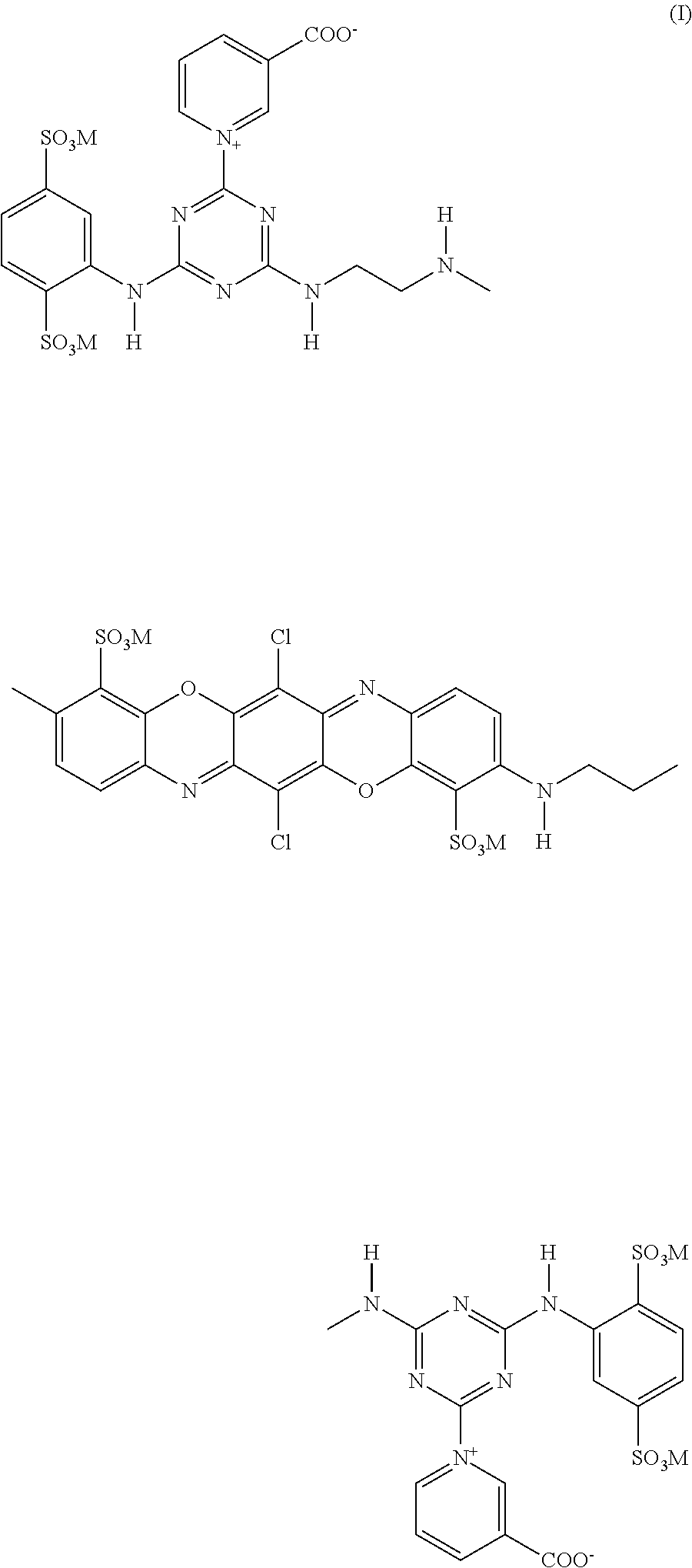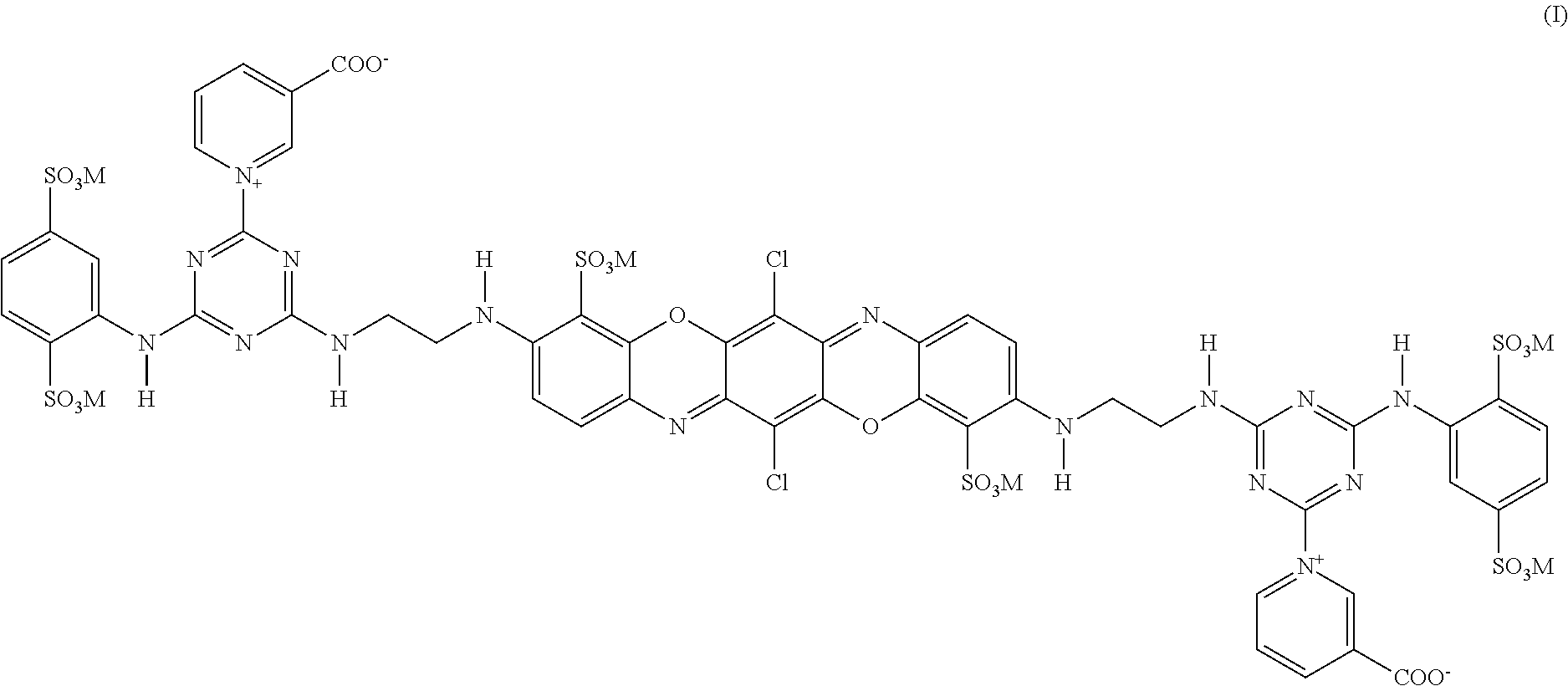Mixtures of fiber-reactive azo dyes
a technology of azo dyes and dyes, which is applied in the field of fiber-reactive azo dyes, can solve the problems of compromising the economics of the dyeing operation, limiting the application of specific dyeing applications, and reactive blue 19 anthraquinone dyes, etc., and achieves high lightfastness, good general fastness, and high fixation yield.
- Summary
- Abstract
- Description
- Claims
- Application Information
AI Technical Summary
Benefits of technology
Problems solved by technology
Method used
Image
Examples
example 1
[0055]In an exhaust dyeing machine was set 10 g of a knit cotton fabric. The liquor ratio and water temperature were adjusted to 1:10 and 60° C., respectively.
[0056]Then, 0.25 g of a dye represented by formula (1) in the sodium salt form:
which had been dissolved previously, 0.75 g of a dye represented by formula (2) in the sodium salt form:
were put into the bath in the conventional manner. Further, 0.60 g of sodium sulfate salt was added into the bath with the dyes. After treating the knit fabric at this temperature for 30 minutes, 0.5 g, in the total, of sodium carbonate was added to the bath followed by 0.1 g of 50% sodium hydroxide in the conventional method. Then, the knit fabric was treated at this temperature for 60 minutes to complete the dyeing. The dyed fabric had a level strong brilliant blue appearance.
[0057]Alternatively, the dye mixture of Example 1 can be pre-mixed in powder or liquid form in the same ratios and then added to the bath. After the dyeing is carried out i...
example 2
[0058]In an exhaust dyeing machine was set 10 g of a knit cotton fabric. The liquor ratio and water temperature were adjusted to 1:10 and 60° C., respectively.
[0059]Then, 0.75 g of a dye represented by formula (1) in the sodium salt form:
which had been dissolved previously, 0.25 g of a dye represented by formula (2) in the sodium salt form:
were put into the bath in the conventional manner. Further, 0.60 g of sodium sulfate salt was added into the bath with the dyes. After treating the knit fabric at this temperature for 30 minutes, 0.5 g, in the total, of sodium carbonate was added to the bath followed by 0.1 g of 50% sodium hydroxide in the conventional method. Then, the knit fabric was treated at this temperature for 60 minutes to complete the dyeing. The dyed fabric had a level strong brilliant blue appearance.
[0060]Alternatively, the dye mixture of Example 2 can be pre-mixed in powder or liquid form in the same ratios and then added to the bath. After the dyeing is carried out i...
example 3
[0061]In an exhaust dyeing machine was set 10 g of a knit cotton fabric. The liquor ratio and water temperature were adjusted to 1:10 and 60° C., respectively.
[0062]Then, 0.50 g of a dye represented by formula (1) in the sodium salt form:
which had been dissolved previously, 0.50 g of a dye represented by formula (2) in the sodium salt form:
were put into the bath in the conventional manner. Further, 0.60 g of sodium sulfate salt was added into the bath with the dyes. After treating the knit fabric at this temperature for 30 minutes, 0.5 g, in the total, of sodium carbonate was added to the bath followed by 0.1 g of 50% sodium hydroxide in the conventional method. Then, the knit fabric was treated at this temperature for 60 minutes to complete the dyeing. The dyed fabric had a level strong brilliant blue appearance.
[0063]Alternatively, the dye mixture of Example 3 can be pre-mixed in powder or liquid form in the same ratios and then added to the bath. After the dyeing is carried out i...
PUM
| Property | Measurement | Unit |
|---|---|---|
| pH | aaaaa | aaaaa |
| pH | aaaaa | aaaaa |
| temperature | aaaaa | aaaaa |
Abstract
Description
Claims
Application Information
 Login to View More
Login to View More - R&D
- Intellectual Property
- Life Sciences
- Materials
- Tech Scout
- Unparalleled Data Quality
- Higher Quality Content
- 60% Fewer Hallucinations
Browse by: Latest US Patents, China's latest patents, Technical Efficacy Thesaurus, Application Domain, Technology Topic, Popular Technical Reports.
© 2025 PatSnap. All rights reserved.Legal|Privacy policy|Modern Slavery Act Transparency Statement|Sitemap|About US| Contact US: help@patsnap.com



